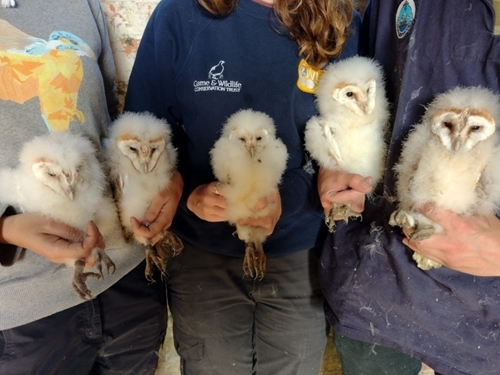3 Minute Read
By the Owl Box Initiative team and guest contributor, Joseph Werling, GWCT Lowland Game Placement Student
 The barn owl’s (Tyto alba) core breeding season, specifically from egg laying to chick fledging, is usually between April and August. But this timescale can vary due to various factors, such as weather conditions, prey availability and the experience of adults in rearing young.
The barn owl’s (Tyto alba) core breeding season, specifically from egg laying to chick fledging, is usually between April and August. But this timescale can vary due to various factors, such as weather conditions, prey availability and the experience of adults in rearing young.
During the 2021 breeding season, the Owl Box Initiative’s monitoring team began box checks in May and continued, at occupied boxes, until the last chicks were ringed in October. The longer breeding season was, in part, due to a number of barn owl pairs across our study areas producing a second brood.

During project monitoring we recorded some large broods of barn owl chicks
Many bird species, such as Blackbirds, Song Thrush, Tree Sparrow and Yellowhammer can produce multiple broods during one single breeding season to increase productivity. A study by Beziers and Roulin (2016) on ‘Double Brooding’ in barn owls suggests that subsequent breeding attempts in one season are dependent on the condition of the birds, with double brooding more likely in barn owl pairs which produce an early clutch and where abundant prey is available.
Interestingly, the study also explains that it is more common for male barn owls, who provides prey continually to the female and growing chicks until fledging, to produce a second brood when they have had a smaller first brood. However, this was not found in females, suggesting double brooding in females improves their reproductive success overall, and does not compensate for any low reproductive success in their first brood.
Further differences in reproductive strategies between male and female barn owls were also observed in the study which highlighted that females, quite often, desert their first mate while he tends her first brood, to carry out a second breeding attempt with another male, possibly due to low quality offspring in the first brood. This suggests females have more opportunities to produce offspring in one breeding season than males.
During our project monitoring, we recorded 7 second broods across two Farmer Clusters, but not all broods were successful. We had an interesting result of a first brood failing, but the adults produced a second brood and successfully fledged 5 chicks. Failure of a nest can be contributed to a range of factors, but early in the 2021 breeding season there was a period of bad weather, which could have negatively affected the hunting ability of the male and reduced the amount of prey brought back to the nest box for the chicks at a critical time. In comparison, another pair of barn owls that we monitored successfully raised and fledged a first brood of two chicks, which were ringed mid-June, with the same pair then raising and fledging a second brood of one barn owl chick into October.
The adaptation to produce multiple broods is a reproductive strategy which can greatly increase productivity for a species. As mentioned above, prey availability can influence multiple breeding attempts and therefore habitat provision for small mammal species such as mice, voles and shrews is a key barn owl conservation measure to incorporate into the farmed landscape.
We would like to say thank you to all the project farmers clusters and their facilitators for working with us, and for providing access to their holdings for us to monitor their barn owl nest boxes.
References: P Béziers and A Roulin, (2016), “Double brooding and offspring desertion in the barn owl (Tyto alba)”, Journal of avian biology.
Support the Owl Box Initiative
You can help support the project by purchasing an Owl Box Initiative Supporter Badge or Living Nature Soft Toy Barn Owl from the GWCT.